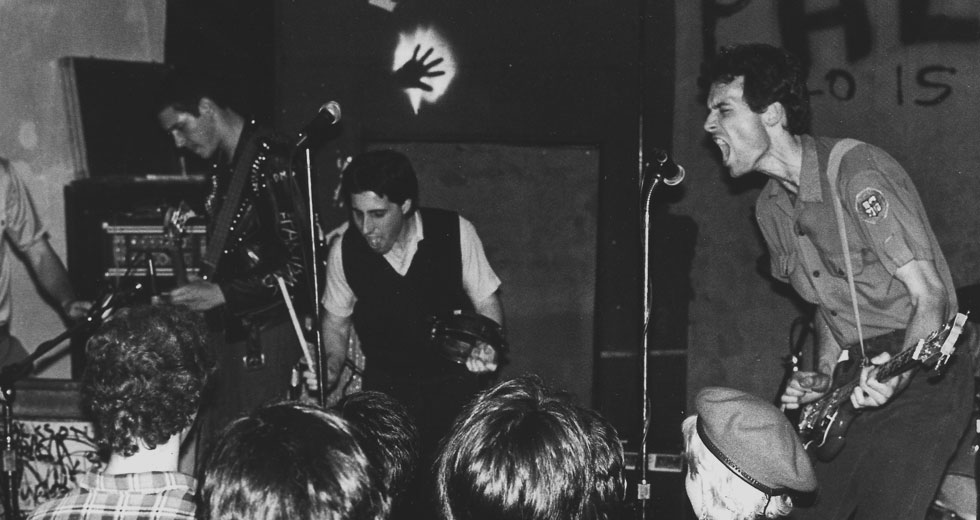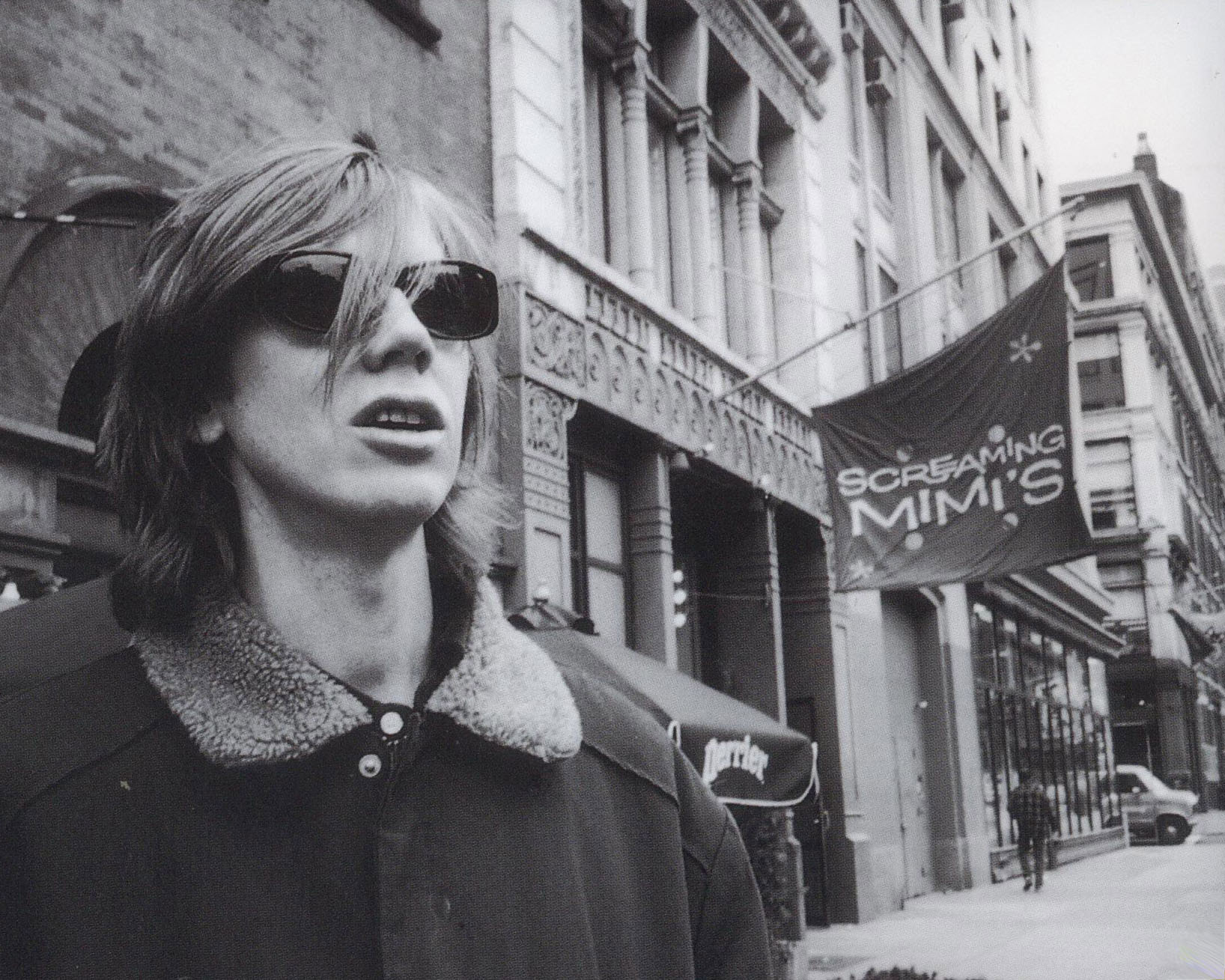Stuart Swezey on the Music and Madness of the Desolation Center
The Los Angeles promoter recalls wild desert happenings, punk harbor cruises and insane industrial freak-outs
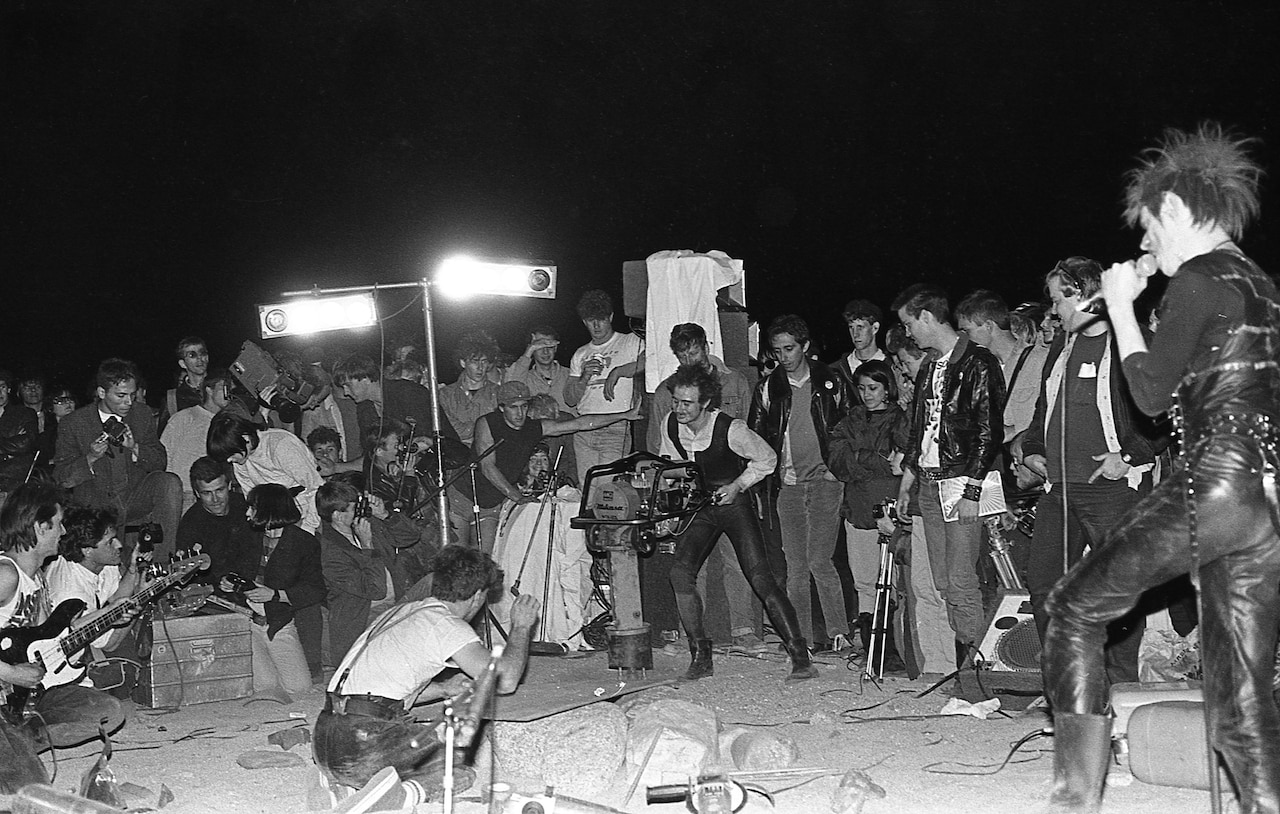
Before Burning Man and Coachella popularized the idea of festivals in the desert, there had already been a series of secret “happenings” in the midst of the Mojave.
Featuring the likes of the Minutemen, Meat Puppets, Savage Republic, Einstürzende Neubauten and, most famously, Sonic Youth, these events were the work of Stuart Swezey, an LA post-punk promoter previously famous for putting on a series of concerts in galleries and rehearsal spaces under the Desolation Center banner.
Swezey was in many ways a trailblazer, a fact reflected in the forthcoming release of Desolation Center, a documentary film chronicling his illegal, experimental events in unlikely desert spots (and, in one case, a whale-watching boat sailing around San Pedro Harbor). Many promoters of renowned alternative music festivals now cite Swezey’s events as inspiration, even if they never attended them.
In this excerpt from a conversation with Frosty for Red Bull Radio’s LAndscape, Swezey talks in detail about Desolation Center’s most infamous events.
For people out there who aren’t familiar with Desolation Center, what is it in a nutshell?
Desolation Center started as a nomadic venue where we could just put on local bands that were experimental or interesting. Then it led to a series of musical happenings out in the desert outside of Los Angeles in the Mojave, as well as some other events like on a whale-watching boat here in San Pedro Harbor. It was the idea of taking music out of conventional venues and presenting it in the landscape in different ways.
What was the window of years that the Desolation Center events happened?
What became the really interesting part would have been from spring of 1983, when we did our first desert show, which was called Mojave Exodus, up until December of 1985.
Where was your head at and what were you up to prior to the Mojave Exodus show that happened in ’83?
I was very involved in what we would have called the scene. It was punk rock, but it was also a lot of just unusual experimental music and performance. I think about people like Johanna Went, who would take a pig’s head and throw it into the audience. I wanted to do something and I thought, “What can I bring to this world that I’m so enamored of?”
I really felt like there needed to be some other kinds of venues, taking this idealism and applying it to the actual places where music and performance were being done. I started with just the blank slate of warehouses and rehearsal spaces. I learned a bit about how to put on an event.
Being an LA person, you end up going to Mexico sooner or later. With some friends, I went driving through the desert south of Arizona, the Sonoran Desert, listening to cassettes of this music that I would say came out of punk rock but had really gone in different directions.
There was a local group, Savage Republic, who were taking some of the short structure punk rock but also banging on metal percussion. They had these interesting soundscapes that felt more like some kind of dystopian third world situation. Listening to that music, driving through the desert, it just occurred to me that that’s where I would literally like to see this kind of music performed. That was where it started.
Had there been, for you, any kind of pretext to that actually in Los Angeles? Had you ever been to an event in the desert? Had you spent much time in the desert outside of Los Angeles?
No. I had certainly never seen a musical event in the desert. I wasn’t super into camping or anything like that. It was more like, “What if we took this music and changed the setting? What would the experience be like?” It was more like an experiment to me.
I had seen the Werner Herzog movie Fitzcarraldo and there’s a character who is trying to build an opera house in the desert, played by Klaus Kinski. At the end, none of the things that he really wanted to happen had happened. He’s been through hell, but he does put on an opera on a little boat floating down the Amazon and he’s totally happy. He feels fulfilled.
From the beginning it was going to be a remote, undisclosed desert location. People had to get on board with something that they weren’t completely in control of.
When I came back from this drive to Mexico and had this idea, the first person I talked to about it was Bruce Licher, who was the driving force behind Savage Republic. He said, “Hey, I know a dry lakebed out near Lucerne Valley,” which is probably a two-and-a-half-hour drive from downtown LA. “We should go out there and scout it and just I’ll show you around.” So we drove out and looked around. I was like, “This is such a beautiful setting. We’ve got to do this.”
What was the setting? Can you describe what that dry lakebed looked like?
Well, the thing that I really remember is that as you come around on a dirt road, it unfolds in front of you. This location was actually called Soggy Dry Lake, but I didn’t know that back then. It’s very flat. It’s sort of surrounded by cliffs, but it almost feels infinite because you have this blank setting and you can see all the way out to the horizon. When you’re in the middle of it, it just changes your whole perspective.
When you started working on the event, how did the logistics come together and what was your vision?
The first questions were, “How do we get people there and how do we finance it?” Somehow the idea of school buses came up, which doesn’t seem obvious in retrospect at all. That way we could charge admission and also know that everybody got there safe and sound. I found a school bus rental company and talked them into letting us rent the buses. They were open to it as long as we could come up with the money for three buses.
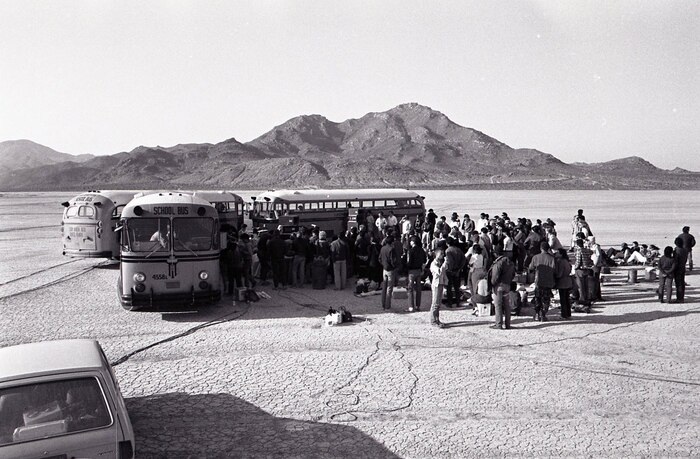
It started as a practical consideration, but I think it allowed us to have people go on a journey with us. We didn’t tell them where we were going. From the beginning it was going to be a remote, undisclosed desert location. That’s all it said on the flyer, so I think that people had to kind of get on board with something that they weren’t completely in control of.
It created a sense of camaraderie because you have all these people that are like-minded [on a bus]. Even if they don’t really have that much in common, they’re interested in this kind of music enough to want to buy a ticket to an unknown location. So all of the sudden, people are talking, exchanging information. They could basically drink on the bus or do whatever other intoxicants were around at the time.
So it was already a party on the way out?
It was a party on the way out, for sure.
And I’m guessing in the parking lot even before the journey?
Right. We had an empty parking lot in Little Tokyo, which was where around 100 people boarded the three buses. So it started right in the center of LA and then it went all the way out to this location, which was pretty remote. I think the whole idea was it was just a day trip. It wasn’t a camping thing. It wasn’t a festival per se. It was almost like a foray into something and then just coming back same night.
So beginning to end, how long was this trip experience?
In theory, they would’ve left around noon and got back at six o’clock, but some of the buses broke down on the way back and nothing went quite according to plan. I think people came back at midnight, something like that. It depended on which bus you were on.
Even the Minutemen went on the buses with their gear, so Mike Watt was on a bus that broke down somewhere. There was some back and forth between the punk rock kids on the bus and some local gangbangers. A rock got thrown, a window was broken and the bus driver had to go out and settle things down. Eventually everybody got home safe and sound.
When people got out to the dry lakebed, how did the event unfold?
There was not too much there when the buses rolled up except our sound guy had set up the PA. Bruce Licher had camped out the night before, so he was there. There was a spot where the bands could play in the middle of the dry lake, with the Savage Republic flag that Bruce had planted.
I felt at that moment, watching the Minutemen in that dry lakebed, “It doesn’t get any better than this.”
We realized before the Minutemen started their set that it was really windy. That was something that we hadn’t really thought that much about. Like, “How do we deal with wind in the middle of the dry lakebed?” We ended up moving the buses so that they could become like a windbreak, so they were actually behind the bands.
The people that came to the event, everybody had their own reaction to it. Some people wanted to wander way off across the dry lakebed, other people wanted to be near where the musicians were actually performing. There was no set way to react to it.
There were some other things going on. A friend of mine had driven down from the Bay Area in an old Galaxy 500. He was taking people on spins around the dry lakebed. There were these land yachts that were basically like sailboats with wheels and they were cruising in the area. They were giving people rides. People were just enjoying being out there on the dry lakebed. Then the Minutemen started playing and that became more of the focus for that time period.
How did it feel for you in that moment?
I felt a sense of accomplishment, I think. I think there was something about that period of time where you just sort of felt like, “This is the coolest spot I could be in right now, period. There’s only 100 other people, two bands, but these are like my favorite bands in the world and we’re in this amazing setting.” I felt in that moment, watching the Minutemen in the middle of the dry lakebed, “It doesn’t get any better than this.”
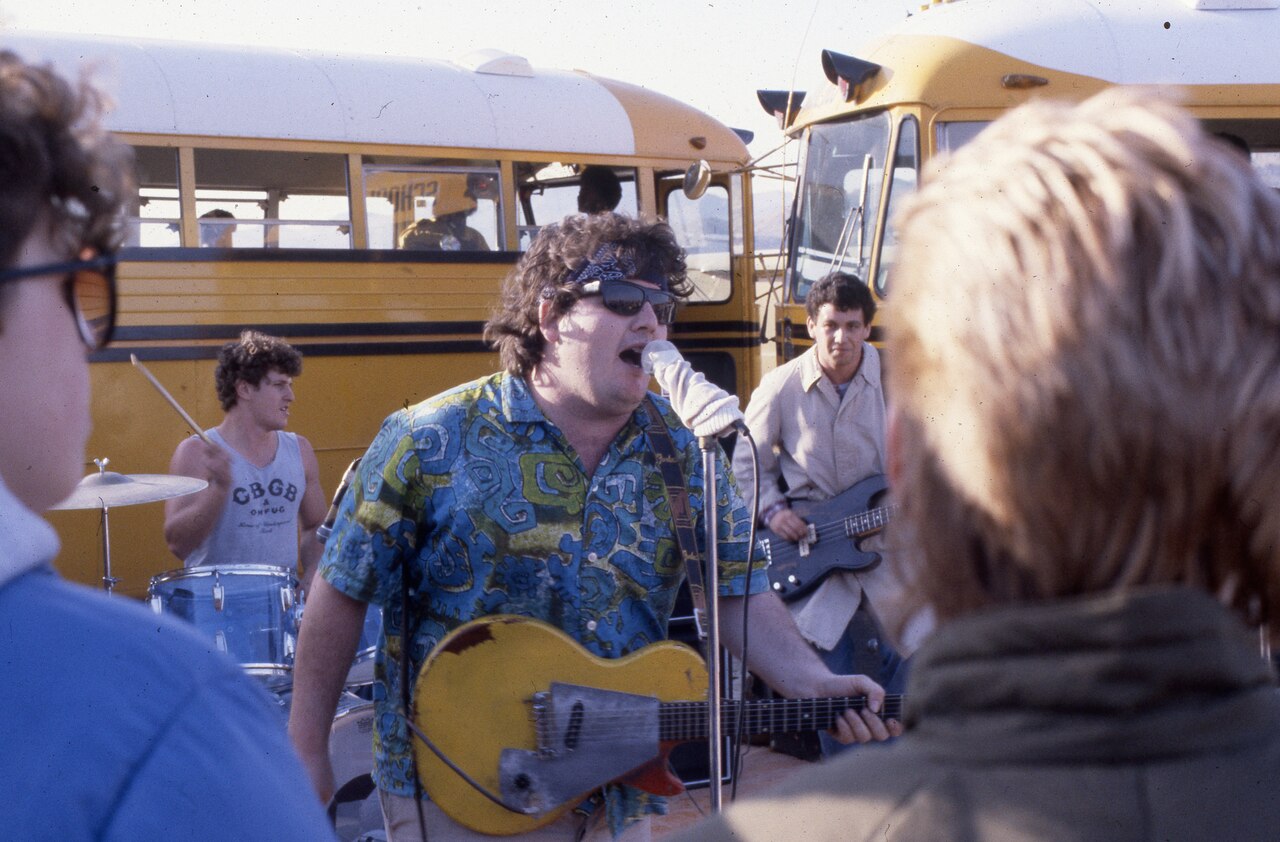
That sense of being in the desert must’ve been so different than a conventional show in the city, in a club, or even in an art gallery within the city. What did that experience of being in the desert lend itself to?
I think it was really a sense of freedom for all of us. There weren’t the conventional constraints of society, which at the time felt very oppressive. Daryl Gates, who was the Chief of Los Angeles Police at that time, was a very authoritarian, menacing figure for people that were trying to actually enjoy their nightlife. Even the atmosphere inside the venues where you could see music wasn’t good. There were bouncers that didn’t really give a crap about the actual music. They had no respect for the musicians or the people that were going to the shows.
This [desert event] was almost like a microcosm of some kind of other approach to society. It only existed for that little time span that we were out there on the dry lakebed and maybe the trip out there and the trip back, but I think it gave this idea of empowerment and possibilities. The lack of anything out there except the desert and some sound equipment or whatever, I think actually led to a feeling of openness.
Was it immediately apparent to you that there needed to be a next chapter, or was this a one-off in your mind?
Looking back on it, it was actually the culmination of all these little Desolation Center shows that I had done in rehearsal studios, galleries and loft spaces. Now I’d done this great one out in the desert. I was done.
I didn’t immediately start to set up any other events. Instead, I quit my job. I bought an Interrail pass and traveled around Europe backpacking. I didn’t really have a strategy to be honest, but I ended up in Berlin in the Cold War, when the wall was still up. I was just amazed. It was a fascinating place. I saw these people living in squats and putting on these really experimental music events.
There was just so much going on there that I felt like, “Why can’t it be more like that where I live in Los Angeles?” I felt a kindred spirit to what was going on there, but I also felt like, “Hey, that’s their place and I need to bring some of that spirit back to Los Angeles.”
Was that the seed for the next chapter of Desolation Center?
Yeah. When I got back to LA I was really broke so I was trying to figure out how to get back in the workforce. Around that time I got a phone call from New York. It was one of the members of Einstürzende Neubauten, at this point a pretty legendary musical group.
I had met them, seen one of their shows in Berlin and hung out with them a little bit. I remember I said to them, “Hey, if you’re ever in Los Angeles, we should do a desert show.” I had done this one desert show at that point in time, but it was one of those things you throw out there and you don’t really think that anything is ever really going to come of it. I didn’t really expect them ever to be in America, let alone California, but they were the kind of people that would take you up on things like that.
Did they understand the kind of setting? Had you shown them photos or just kind of casually mentioned the previous event?
It was very much the latter. They knew who Savage Republic were, I think, because they were close enough musically that they were in touch. I’m not sure if they were familiar with the Minutemen or not, but I think they got it. They were like, “Oh, noisy music, experimental, primal-sounding music out in the desert… That would be great!”
I think they really liked the idea of a completely different venue. Even their most unusual shows at that point in time were still in nightclubs. They never had a place that was just this complete wilderness environment where they could do what they did, which in a sense was the polar opposite of where they came from. They got it. They weren’t going to miss this opportunity.
They said, “We’re going to be in LA in two weeks.” I said, “Do you want to do a desert show?” Part of me was a little bit stressed out because I didn’t really know how to put on a bigger desert show than the earlier one and then part of me was just really, really excited. I felt that since I had offered to do it, I had to go through with it because this could be the most amazing desert show yet. At the same time, it was a scramble for sure.
What did you end up by doing as far as the next step?
I had decided it wasn’t going to be the same dry lakebed. It had to be a different environment and so again, with Bruce Licher from Savage Republic, I tried to figure out where to put on the show. We were looking at a map of the desert and saw a little town called Mecca, California. We thought, “Oh, let’s go there, Mecca. That would be so cool.” Mecca was calling to us, so we drove out there. It turns out that it is about 15 minutes drive from where the Coachella festival is now.
We drove down this closed highway and into this beautiful landscape with lots of cliffs. It felt like a dinosaur was going to come out around the corner, or maybe you were on Mars or something like that. We knew we had a location and it was even further than the last one. It was like a three-and-a-half-hour drive, but that was where we were going to do it.
How did the rest of the lineup fall into place?
Einstürzende Neubauten were part of this international industrial culture community. One of the people that they knew was Mark Pauline from Survival Research Laboratories, who wasn’t a musician at all but did these performances using remote control, mechanized machines with animal parts and flamethrowers. Nobody had really seen him live outside of the Bay Area, but there was a book that RE/Search Publications had published, The Industrial Culture Handbook. I loved that book so I knew exactly who Mark Pauline was.
Everything went incredibly smoothly when you consider how much potential there was for things going wrong, whether it be explosives or people on hallucinogenic drugs climbing cliffs.
The guys from Einstürzende Neubauten said, “Do you want to have him be part of the show?” When we got on the phone together I was kind of surprised. He was just like, “Yeah, for gas money we’ll come down and we’ll do something.” I didn’t really ask him what he was going to do. It was just like, “Great. Mark Pauline’s in.”
Bruce, once again, was involved. He had something that he wanted to do, which was very different than Einstürzende Neubauten playing power tools and banging on metal. It was to be acoustic percussion in the cliffs. He organized it with some members of Savage Republic and other friends of his. That was going to be like the welcoming committee as people got off the buses, setting up the rest of the performances.
Another person that was part of this industrial scene was Boyd Rice, who Einstürzende Neubauten also invited to be part of it. He came up with this idea of what he called a “carnival trick,” which was lying on a bed of nails with a big cinder block on his chest. Then Alexander Hacke from Einstürzende Neubauten would break it with a sledgehammer. When he came to do it, it was all mic’d up. As the cinder block was breaking on his chest, the sound was echoing around the canyon.
Survival Research Laboratories couldn’t really bring all their machines down, so they made a lot of black powder, basically homemade dynamite. When they got to the location, they found all these old refrigerators and appliances that had just been left out in the desert. They assembled them into what Mark called “totem poles.” Then they blew them up as part of their performance. It created a whole vibe that was more, I would say, Mad Max than the first one.
During that event, did everything go to plan?
I would say that everything went incredibly smoothly when you consider how much potential there was for things going wrong, whether it be explosives or people on hallucinogenic drugs climbing cliffs. Any number of things could have really gone wrong and nothing did.
One thing that Mark Pauline told me more recently was that one of the explosions they set off had a metal plate that was supposed to fly over the audience. It didn’t go over the audience at the height it was supposed to, so it was only ten feet over people’s heads. The whole time, he was worried that somebody was going to get their head cut off by this metal plate, but it didn’t happen. At the time I didn’t even know that it was a potential problem.
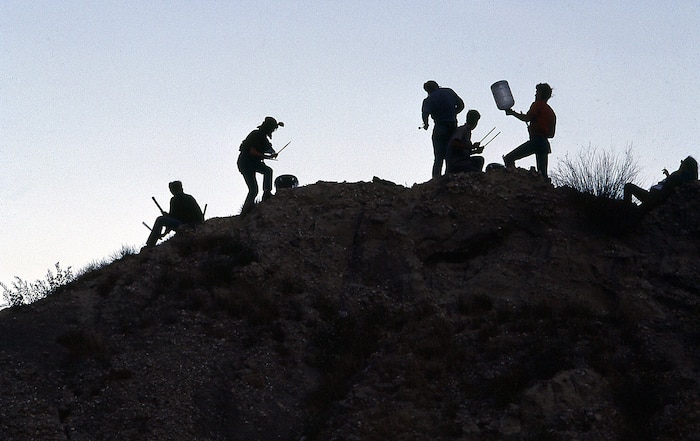
The show ended up being called Mojave Auszug, which is Mojave Exodus in German. It took place on March 4, 1984. The next event was called Joy at Sea. What can you remember about that?
It occurred to me that water would be the opposite of a desert, at least in my mind, and so then that led to the idea of doing a show on a boat. At that point in time, again through being friends with the Minutemen, I was driving down here to San Pedro a lot. I knew that the environment here was really important to the Minutemen and the way they presented themselves through music. I thought, “Well, what better than to do a Minutemen show on a boat in the harbor?”
It was just another kind of logistical challenge. Eventually I found a whale-watching boat that was actually docked in Redondo Beach, but they were willing to bring the boat up here to San Pedro and just cruise around. We decided it would be a three-hour tour like Gilligan’s Island. The Minutemen were completely on board with it and they brought the Meat Puppets in, which was really exciting for me.
What we decided we were going to do is have two bands on the deck. There was also the below deck area where people could get a drink and hang out, so we had two musical groups there, these friends of mine. Lawndale had just started and they were doing sort of instrumental surf-inspired stuff. There was also Points of Friction, who were doing experimental tape loop stuff with slide projections.
They were flying a Minutemen flag off the back of the boat. That was apparently a violation of international maritime law. It almost ended before it started.
It became Joy at Sea, which was inspired by Minutemen songs, “Joy” and “More Joy.” I think at that point in time, the whole hardcore thing was becoming somewhat of a cliché and a little bit oppressive. I liked the idea of just calling it Joy at Sea. It’s something that was really not about aggression or anger and all that kind of stuff. This was maybe an opportunity to just celebrate our own scene and the creativity of people like the Minutemen.
The setting was very different to the previous desert events. Did it feel like a continuum to you?
Yes, I think it did. I remember a moment going under the Vincent Thomas Bridge when the Meat Puppets were playing at the beginning, and just the sound echoing under this bridge. It still felt like a very different sense of a place to experience music from your typical venue or club, and so there was also a sense of adventure.
In another way, it was the cliché of the party boat. People were drinking a lot and people were packed together, but these bands at that point in time were so great. It was right before the Minutemen released Double Nickels on the Dime, which is just a classic double album. Meat Puppets are in between Meat Puppets II and Up On The Sun so you’re getting this incredible musical experience at the same time.
Bringing all of those people out to sea, anything could have happened. Was there a moment when it went awry, or did it run smoothly?
Again, it all went really smoothly and almost miraculously so. We built this little wooden stage, with two columns of speakers on either side of it that were just roped down. The Minutemen’s D. Boon was a big guy then and he would always jump up and down and really just feel the music. He’d be leaping while he was playing and singing. I think we were all kind of like, “What if he goes overboard?” That was very memorable. He didn’t and no one else did.
People kept it together. Before the show, the harbor patrol actually pulled over our rented boat because we had the Joy at Sea banner and a Minuteman banner made by D. Boon that had their name, San Pedro and an anchor on it. They were flying it off the back of the boat on the way up from Redondo Beach to San Pedro. Apparently that was a violation of international maritime law and the harbor patrol said they were flying a flag of unknown origin that they had to take down. It almost ended before it started.
When people came to these Desolation Center happenings, they were also greeted with a visual aspect, whether that’s a hand-painted banner for Joy at Sea or beautiful homemade tickets. Was that something that was an important aspect of the events?
I think for me the biggest part of it was the actual setting itself. That was the important thing, whether it was the harbor at night, a canyon out in the desert or a dry lakebed. The artistic aspects of it came about because so many people that were involved, either participating as musicians or people just going to the shows were artistic.
Anthony Ausgang is a painter that is pretty well known in the “lowbrow” art world. He did a banner that was behind Lawndale for the Joy at Sea show. He said it was the first time anybody had publicly seen his art, so for him that was a really big deal, a career motivating thing. He feels that people now associate festivals with art, with visuals and for him, that wasn’t really something that was so prevalent before these shows. It’s interesting. I haven’t thought about that connection, but it’s important to him.
We should talk about the Gila Monster Jamboree in January 1985, which featured some familiar faces. How did that come about?
That was the last desert show that I was involved with and it really came about because of seeing Sonic Youth at a club in Berlin. I think if I hadn’t seen them back in ’83, I probably wouldn’t have been as excited about putting them on out in the desert in the beginning of 1985. I introduced myself, again, just after the Berlin show. Because they were American, I felt like I could go up and talk to them. At the time they were just wandering from one European city to the other.
I don’t think I actually even offered them the idea of doing a desert show then, but because they were here in Los Angeles, I met them again and we started talking about this possibility. It just seemed like what a great venue for what they were doing. They had just put out the “Death Valley ’69” single, so there was sort of this fascination with Charles Manson going to the desert and Death Valley.
Again, not an obvious place to put on a Sonic Youth show because they were very much associated with New York and this East Village sensibility or whatever, especially for people out here in California, but at the same time it was actually a really perfect idea because I think they were very interested in dark aspects of Americana.
Kim Gordon and Thurston Moore were together then. Her family lived in LA and so they were going to be visiting her parents over the holidays. They were like, “Well, we can stay until after New Year’s and then we can do a desert show.” So we picked the first full moon after New Year’s and we went back to the location where we did the first desert show, but used a different side of the same dry lakebed.
We all went out there and scouted it. There was a graffiti spray-painted Blue Öyster Cult symbol on a rock. Thurston was like, “That’s where we’re going do it, under the Blue Öyster Cult symbol.”
I think it was sometimes very transformative for people just being at these events. They felt that they could maybe do things that they wouldn’t have thought were possible otherwise.
It was Sonic Youth, Meat Puppets and Redd Kross. Sonic Youth were huge Redd Kross fans. It was also this sort of idea of breaking away, for the people who were breaking away from the hardcore conformity. Redd Kross in their own way were very emblematic of that. They had this camp rock star thing that they were doing, even though they were basically just kids still at the time.
It was those three and then Perry Farrell, who was one of those people I think had been in all the shows, was involved in one way or another. By that time, I was roommates with him and so he really wanted to have his band, Psi Com, which was pre-Jane’s Addiction, be on the bill. That was the lineup and I think that was the first time Sonic Youth had played for a West Coast audience at all. It was an amazing way to introduce a lot of people to their music.
Was it totally different sonically than you had experienced from them in the past?
I had only seen them that one time in Berlin, so I knew there were certain aspects of what they did with their tuning and the way that they played these conventional rock instruments where it sounded like this completely other sort of thing. It was a revelation just to hear it in that setting, for me. It wasn’t so much that it was so different to what I had heard before, but they had evolved. At Gila Monster Jamboree, it flowed out of this noisy kind of dissonance and then into a song, and then back into something dissonant again. It almost felt like one whole song in a sense. It just all flowed together. They were just doing some really interesting things with sound.
We’ve been talking about four major events that happened as moments in time. You brought people to these settings and felt like this was the most important place for you in the universe at that time and place. It surely impacted the audience. What were some of the ripple effect of these happenings? Have people told you?
I think it was sometimes very transformative for people just being at these events. They felt that they could maybe do things that they wouldn’t have thought were possible otherwise. On a bigger level it was the introduction of Sonic Youth to a lot of what was going on here in Southern California. They ended up putting out a record with SST and working with filmmaker Dave Markey, so there was a cross-pollination out of the Gila Monster Jamboree that led to this West Coast/East Coast culture that became to be known as alternative. It’s kind of a bland word, but that led up to Nirvana and things like that.
It’s interesting that your roommate at that time, Perry Farrell, went on to found Lollapalooza. What moved you to pause and stop doing events on this scale?
I think I felt in a way that things were getting too big. I don’t know. There was something about the scale of it just being a couple of hundred people or three or four hundred people with the Gila Monster Jamboree. For that one, we let people drive themselves out using a map checkpoint as well as having the buses. It certainly felt more like I was getting into conventional rock territory, even then.
There was also the element that none of the shows were permitted. The Bureau of Land Management actually came and contacted me and I had to work out a settlement with them. We actually did a benefit with the Minutemen to raise the money to pay the Bureau of Land Management. When the rangers first found me I realized I couldn’t really do this unpermitted any more. It was never supposed to be an annual event like a festival and I just didn’t see the need to keep doing it.
